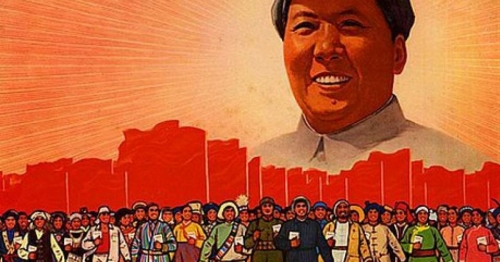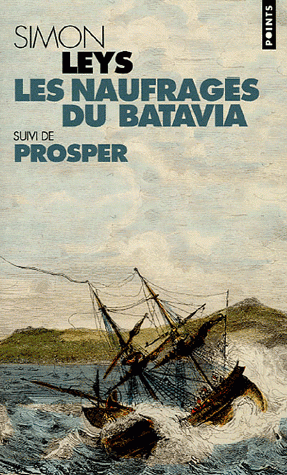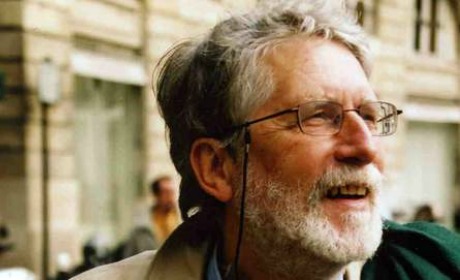Simon Leys was perhaps the pre-eminent Western chronicler of Mao’s Cultural Revolution, and it is worth returning to his work for its vivid first-hand accounts of life in Beijing during this period. But Leys was also interested in the process by which, under the right conditions and with the right ideology, a society can collapse into insanity and murder. His description of the Cultural Revolution showed how political hysteria and the legitimization of violence and hatred combined to ravage a nation.
These developments, however, are by no means unique to communism in general or China in particular, and Leys explored similar themes in his retelling of the harrowing true story of a ship wrecked off the coast of Australia in 1629. His book on the topic, The Wreck of the Batavia, is a short masterpiece about how the small society that the ship’s survivors tried to construct in the wake of the disaster was plunged into apocalyptic madness and murder by a psychopathic leader operating according to his own deranged totalitarian ideology. The parallels to Maoism—although Leys was too elegant a writer to belabour them—are obvious.

Leys’s work was not centered on abstractions or historical lessons. “I am not dealing here with esoteric abstractions, but with a living reality,” he wrote in the introduction to the anthology The Hall of Uselessness. He was preoccupied with the fragility of civilization, the vulnerability of human nature to the temptations of cruelty, and the complacency of advanced societies when viewing the barbarism of others.
The Cultural Revolution
Simon Leys was born Pierre Ryckmans in 1935 into a distinguished Catholic Belgian diplomatic family (his uncle was the governor general of the Congo). His adult life was spent in greater China or studying it from Australia, where he died in 2014. During the 1960s and ’70s, he was partially blacklisted in Paris for the candor of his indictments of Maoism and scathing criticisms of French Maoists like Roland Barthes. Despite these views, Ryckmans was never entirely ostracized in Paris, where the Situationists published him, nor even in China itself. But his opinions did require him to adopt a pseudonym in print so that he could take up a post as a cultural attaché to the Belgian embassy in Beijing in 1972.
Leys’s breakthrough insight into the Cultural Revolution was that it was not a spontaneous development but arose instead from a power struggle between Mao and the Central Committee which included Deng Xiaoping. Years earlier, Mao’s “Great Leap Forward” had led to a devastating famine and an estimated 30–45 million deaths. In response, Deng and the Central Committee forced Mao into a largely ceremonial role, or in the Chinese phrase, “laid him to rest in a sidetrack.” The Cultural Revolution was Mao’s instrument of revenge. Amid the ensuing mayhem and the mass murder of his opponents by the Red Guards, Mao was able to regain power. He then ordered the Army under Lin Biao to rein in the Red Guards who were themselves often massacred. In 1971, Lin Biao also disappeared. According to official sources, he died in a plane crash in Mongolia trying to flee the country. According to Leys and informed sources, Mao ordered Lin’s assassination inside China and the crash story was a fabrication.
 “Mao managed to light the fuse that would lead to that huge explosion, the Cultural Revolution,” wrote Leys. The sequence of events he described that led to that upheaval makes the process sound methodical, but the rage and violence unleashed defy rational analysis. Roving mobs of Red Guards composed of teens and children murdered with impunity. Ancient statues, temples, and buildings were destroyed. All books, films, and magazines that predated the Cultural Revolution were withdrawn, and universities and schools were closed. Professors were harassed by the “Workers-Soldiers Propaganda Teams of the Thought of Mao Tse-Tung,” and were sent to factories or the countryside. “Proletarians” replaced them when the universities tentatively reopened in 1972. This policy did not prove to be successful. Re-educated professors were allowed to return to teaching, but only under the watchful eye of the worker-soldiers propaganda teams. The content of the classes was now predominantly political theory.
“Mao managed to light the fuse that would lead to that huge explosion, the Cultural Revolution,” wrote Leys. The sequence of events he described that led to that upheaval makes the process sound methodical, but the rage and violence unleashed defy rational analysis. Roving mobs of Red Guards composed of teens and children murdered with impunity. Ancient statues, temples, and buildings were destroyed. All books, films, and magazines that predated the Cultural Revolution were withdrawn, and universities and schools were closed. Professors were harassed by the “Workers-Soldiers Propaganda Teams of the Thought of Mao Tse-Tung,” and were sent to factories or the countryside. “Proletarians” replaced them when the universities tentatively reopened in 1972. This policy did not prove to be successful. Re-educated professors were allowed to return to teaching, but only under the watchful eye of the worker-soldiers propaganda teams. The content of the classes was now predominantly political theory.
The traditional university entrance exam system was eliminated. Replacing it, Leys observed in Chinese Shadows, was an admissions system that was “tightly political: a candidate who is not the son of a worker or a poor peasant has practically no chance of admission, however brilliant he may be.” There was no risk whatsoever that these poorly prepared students, once admitted, would fail. Leys spoke to a University of Peking professor who told him, “As for failing a student who happened to be an activist or the son of a poor peasant, needless to say, this kind of foolhardiness did not occur to anyone.” (It was only after Mao’s death that university admissions based on competitive exam, rather than the student’s political background and social origin, were restored by Deng.)
Under Maoism, there was no objective truth and hence no objective science. A key Maoist document “The May 16th Circular” reads, “the slogan: ‘everyone is equal before the truth’… is a bourgeois slogan… completely negating the class nature of truth.” The class struggle was of course central to Maoism but Leys termed it “the great hoax.” The violent hunt for the bourgeoisie was all-consuming but there were no authentic bourgeoisie left in China, a society which consisted only of the Party and the People. The bourgeoisie needed to be invented, given they were “practically extinct in China,” wrote Leys. The source of the supply, he noted, was the ruling classes’ “perpetual merciless power struggle: the winning group always gives the unlucky losers a ‘bourgeois-capitalist’ label and then abandons them to popular fury.” History too, was subordinate to political truths and expediency. In The Burning Forest Leys reported a trip to a history museum during which a flummoxed guide was unable to answer visitors’ questions: “The leadership has not yet had the time to decide what history was.”
The Cultural Revolution marked an intensification of ongoing trends in China rather than a clean break. This can be seen most clearly in art and literature. In 1942, Mao delivered his “Talks at the Yenan Forum on Literature and Art,” in which he declared:
There is in fact no such thing as art for art’s sake, art that stands above classes or art that is detached from or independent of politics… Party work in literature and art occupies a definite and assigned position in Party revolutionary work as a whole and is subordinated to the revolutionary tasks set by the Party.
The arts in Mao’s China closely followed these guidelines, with the edict to destroy creative “moods” alien to the proletariat, such as liberalism, individualism, pessimism, or “art for art’s sake.” Bookshops only featured the works of Chairman Mao. His calligraphy and sayings were stenciled everywhere and on everything: trains, factories, buildings, dams, and army barracks.

It is worth mentioning contemporary American art in this context, mostly to illustrate its limitations and inadequacies. The visual arts in the US, including painting, are increasingly what is known as “post autonomous.” That is, the ideas are all imported from other fields. Art is merely another form of political engagement, with a stress on ecological and identitarian themes. The goal is to bring about radical political confrontations, not aesthetic ones. Works and people—including even museum trustees—incompatible with the constantly shifting post-autonomous agenda are purged.
But if art is now merely a vehicle for ideas from other fields, what exactly is its value? This is a question no one in the arts is asking. But Mao did. In his “talk on Arts and Letters” he stated:
Politics cannot be equated with art, nor can a general world outlook be equated with a method of artistic creation and criticism… we oppose both the tendency to produce works of art with a wrong political viewpoint and the tendency towards the “poster and slogan style” which is correct in political viewpoint but lacking in artistic power. On questions of literature and art we must carry on a struggle on two fronts.
The solution to this self-imposed dilemma was found in Madame Mao’s Revolutionary Model operas. These replaced traditional operas, the most popular art form in China, with new operas with revolutionary themes. Leys wrote:
Theatres, movies, radio, and television, were taken over every day, all day for years, by Madame Mao’s six revolutionary model operas… Nothing else was produced. They are broadcast in restaurants, railway stations, and trains and planes… [giving] this catastrophic grotesque a nightmarish ubiquity, and its multi-repetition every day, all week, months on end, throughout the year, is a saturation that brings on nausea, a screaming boredom.
 Leys didn’t turn to an analysis of Marxist theory to unlock the true character of Maoist rule because he didn’t feel this was driving it. His understanding of the dynamics of the regime came from his own observations, as well as the writings of Father Ladany, a Hungarian Jesuit and China watcher based in Hong Kong. Referencing Ladany, Leys wrote in an essay The Hall of Uselessness: “A communist regime is built on a triple foundation: dialectics, the power of the party, and secret police—but as to its ideological equipment, Marxism is merely an optional feature.” According to this analysis, the Communist Party is best understood as essentially a secret society that rules through terror and deception. The Party’s path to power was obscure, arising out of economic and social chaos of the 1940s. It used propaganda and tight organization to turn a miniscule movement into the embodiment of the nation’s will.
Leys didn’t turn to an analysis of Marxist theory to unlock the true character of Maoist rule because he didn’t feel this was driving it. His understanding of the dynamics of the regime came from his own observations, as well as the writings of Father Ladany, a Hungarian Jesuit and China watcher based in Hong Kong. Referencing Ladany, Leys wrote in an essay The Hall of Uselessness: “A communist regime is built on a triple foundation: dialectics, the power of the party, and secret police—but as to its ideological equipment, Marxism is merely an optional feature.” According to this analysis, the Communist Party is best understood as essentially a secret society that rules through terror and deception. The Party’s path to power was obscure, arising out of economic and social chaos of the 1940s. It used propaganda and tight organization to turn a miniscule movement into the embodiment of the nation’s will.
But Mao did formulate one theoretical innovation, which Leys took extremely seriously. “Mao explicitly denounced the concept of a universal humanity; whereas the Soviet tyrant merely practiced inhumanity, Mao gave it a theoretical foundation, expounding the notion—without parallel in the other communist countries in the world—that the proletariat alone is fully endowed with human nature.”
The end result was a deeply scarred society: “For those who knew it in the past,” Leys wrote in 1977, “Peking now appears to be a murdered town. The body is still there, the soul has gone.” The revolution disfigured the psyche as well. The constant political campaigns, revenge, and struggle sessions, eroded any notion of shared humanity. As Leys observed, “twenty years of systemic incitation to ‘class hatred’ and denunciation of basic impulses such as a compassion for suffering whoever is the victim… has brought about the general and willed lowering of the traditional virtues that gave harmony to Chinese life.”
Replacing that harmony was a New Man, with new qualities: kindness had vanished. This absence of kindness was true in Soviet Russia as well and is in some ways the defining characteristic of a totalitarian society. In Chinese Shadows Leys quoted Nadezhda Mandelstam on the impact of Stalinism: “Kindness is not, after all, an inborn quality, but it has to be cultivated, and this only happens when it is in demand… Everything we have seen in our times—the dispossession of the kulaks, class warfare, the constant ‘unmasking’ of people—all this has taught us to be anything you like, except kind.”
The Wreck of the Batavia
A 17th century shipwreck and mutiny off the coast of Australia seems at first glance like an incident remote from Mao’s China in almost every way. But it is actually a strangely related tale informed by similar totalitarian dynamics, so it is not surprising that Leys was so fascinated by the grim story of the Batavia. The story of what happened to the ship and its crew had gripped the world at the time it unfolded but was then largely forgotten until interest was rekindled by the re-discovery of the wreck in 1963. Leys’s research relied on documents from the original trial as well as the book Batavia’s Graveyard by Mike Dash.
 The Batavia was a merchant ship which set sail on its maiden voyage in 1628 from the Netherlands to Java under the command of Dutch East Asia Company official, Francisco Pelsaert. The ship, for its time, was massive—it carried 330 people and was double hulled for the 15,000 mile journey. (It was, in fact, so tall that a replica could only clear Sydney Harbor Bridge at low tide.) Such a long and dangerous voyage in the largely unexplored Southern Ocean attracted only the most desperate crew, who were unable to find employment in the Dutch Navy or the Army. Pelsaert was a merchant, not a sailor. The actual skipper, a drunk named Ariaen Jacobsz, was therefore technically not in charge of the ship and the two men hated one another. Also aboard was Jeronimus Cornelisz, a failed apothecary who now worked for the Dutch East India Company. Cornelisz was a known associate of the painter Torrentius, who had recently been arrested for heresy and satanism, and the authorities were searching for any accomplices.
The Batavia was a merchant ship which set sail on its maiden voyage in 1628 from the Netherlands to Java under the command of Dutch East Asia Company official, Francisco Pelsaert. The ship, for its time, was massive—it carried 330 people and was double hulled for the 15,000 mile journey. (It was, in fact, so tall that a replica could only clear Sydney Harbor Bridge at low tide.) Such a long and dangerous voyage in the largely unexplored Southern Ocean attracted only the most desperate crew, who were unable to find employment in the Dutch Navy or the Army. Pelsaert was a merchant, not a sailor. The actual skipper, a drunk named Ariaen Jacobsz, was therefore technically not in charge of the ship and the two men hated one another. Also aboard was Jeronimus Cornelisz, a failed apothecary who now worked for the Dutch East India Company. Cornelisz was a known associate of the painter Torrentius, who had recently been arrested for heresy and satanism, and the authorities were searching for any accomplices.
The atmosphere on the ship was stifling. “These ill-assorted individuals,” Leys wrote, “were bundled up in the heavy black suits that the Dutch sense of proprietary dictated they wear, even in the tropics.” Ten men succumbed to scurvy, the cause of which was not yet known. During the voyage, Cornelisz began sharing some of the ideas he had learned from Torrentius with Jacobsz such as, “Are crimes by God’s elect crimes at all?” and tried to persuade the skipper to join him in a mutiny to seize control of the ship from Pelsaert. The ship was carrying 12 treasure chests to buy spices, and Cornelisz wanted to divert to an English colony.
The mutiny didn’t take place as planned but the situation onboard the ship was tense and restive. Then, on June 3rd, 1629, the ship’s lookout saw what he thought were waves breaking over shallows. He alerted Jacobsz who told him this was impossible because he thought the ship was 600 miles to the north in open seas. But at that time there was no easy way to measure longitude. In reality, the Batavia was wildly off course, close to the West Coast of Australia, and sailing amidst an archipelago of tiny coral islands called the Houtman Abrolhos. It was there that the Batavia struck a reef.
This seemed to spell certain death for the passengers. The sea would break the ship apart and drown them all. Lifeboats had not yet been invented and few people could swim. Authority and discipline dissolved. “Mercenaries and sailors broke into stores of wine and spirits and engaged in a wild orgy,” Leys wrote. “Every taboo was swept away.” However, as the tide receded, it became possible to wade to a nearby island, and most onboard made it to safety. But 70 were too fearful to leave the wreck, and chose to stay on the ship until the very end. When it broke apart nine days later most of them drowned. But even for those who had made it to the island, chances for long-term survival were bleak.
 The Batavia carried a small open boat, and under cover of darkness, the skipper and captain set off from the island to Java over 1,800 miles away to seek help (or simply to save themselves). The survivors of the Batavia awakened to find that they had been abandoned. Cornelisz was the most senior remaining Dutch East Asia Company employee and was therefore the natural leader of the survivors. Unfortunately, he turned out to be a psychopath. Under Company rule, all decisions had to be made by committee. Cornelisz had made certain that all committee members were his fellow plotters in the planned mutiny. Now, they controlled all of the weapons from the Batavia, as well as a few rafts constructed out of its wreckage. The committee almost immediately ordered the execution of a soldier accused of stealing wine. This was the first of many murders.
The Batavia carried a small open boat, and under cover of darkness, the skipper and captain set off from the island to Java over 1,800 miles away to seek help (or simply to save themselves). The survivors of the Batavia awakened to find that they had been abandoned. Cornelisz was the most senior remaining Dutch East Asia Company employee and was therefore the natural leader of the survivors. Unfortunately, he turned out to be a psychopath. Under Company rule, all decisions had to be made by committee. Cornelisz had made certain that all committee members were his fellow plotters in the planned mutiny. Now, they controlled all of the weapons from the Batavia, as well as a few rafts constructed out of its wreckage. The committee almost immediately ordered the execution of a soldier accused of stealing wine. This was the first of many murders.
Next, Cornelisz culled the population, particularly the strongest men, by shipping them to remote atolls where he believed there was no water and where he left them without a boat. One group, led by a soldier named Wiebbe Hayes sent a smoke signal indicating that they had found water, which is not something Cornelisz anticipated. And there were abundant wallabies to eat! When other survivors took to rafts to join Hayes, Cornelisz’s men dragged the rafts back to shore and beat the men, women, and children to death on the beach.
Cornelisz established a terror state and ordered arbitrary executions. He retitled himself “Captain General” and made everyone swear loyalty to him. He and the committee wore beribboned officers’ uniforms salvaged from the Batavia and drank the wine. Women were held as slaves and raped. A Dutch aristocrat named Lucretia van der Mijlen, who had been travelling as a passenger along with her maid, was spared and told to become Cornelisz’s concubine. She refused until a deputy explained that either she accede to the Captain General’s request or she would be killed or raped or both. Upon receiving this news, she complied.
Although Cornelisz’s personal psychology explains some of this violence, Leys stresses that his actions were informed by the heretical and libertine theories of Torrentius, who claimed the Devil helped him to paint. Torrentius was jailed and tortured in 1628 and his paintings were burnt. Only one of his works has survived—“Still Life with Flagon, Glass, Jug and Bridle” was rediscovered in 1913 being used to cover a barrel of raisins and now hangs in the Rijksmuseum. It remains mysterious—with no visible brushstrokes it resembles a photograph, and Torrentius may have used an unknown chemical process in its creation.
 But Cornelisz held his own heretical beliefs which were independent of the provocations of Torrentius. Cornelisz was an Anabaptist, an often violent millenarian sect that favored adult baptism—a profoundly shocking and subversive heresy at the time—and foresaw an apocalyptic struggle for salvation as described in the Book of Revelation. (In 1553, the Anabaptists established a millenarian proto-communist city state in Münster, characterized by common property, polygamy, and terror. Although Leys didn’t mention it, Maoism and Stalinism were intellectual descendants of Anabaptism. Here the millenarian ideology was delivered in secular form with leaders prepared to precipitate an apocalypse in pursuit of utopia.)
But Cornelisz held his own heretical beliefs which were independent of the provocations of Torrentius. Cornelisz was an Anabaptist, an often violent millenarian sect that favored adult baptism—a profoundly shocking and subversive heresy at the time—and foresaw an apocalyptic struggle for salvation as described in the Book of Revelation. (In 1553, the Anabaptists established a millenarian proto-communist city state in Münster, characterized by common property, polygamy, and terror. Although Leys didn’t mention it, Maoism and Stalinism were intellectual descendants of Anabaptism. Here the millenarian ideology was delivered in secular form with leaders prepared to precipitate an apocalypse in pursuit of utopia.)
A handful of escapees managed to flee Cornelisz’s island on rafts and warned Wiebbe Hayes and his fellow soldiers about Cornelisz’s reign of terror. Anticipating an attack, Hayes’s group built a makeshift fort out of coral, the first European structure in Australia. Two months after the original wreck, Cornelisz’s men attacked Hayes and his largely defenseless companions with muskets. Amid the final battle, a ship was spotted on the horizon. The commander Pelsaert had made it to Java and had returned to rescue the company’s treasure chests and the survivors. Hayes got to the rescue ship first.
Pelsaert could hardly believe what had occurred in his absence. Cornelisz was arrested, tortured, and tried “on the spot,” and his hands were cut off. He was sentenced to death, along with six accomplices. He remained faithful to his heresy and declined to be baptized before he was hanged. Two of his junior henchmen were spared the rope and left on the Australian mainland to fend for themselves with toys to establish friendly relations with the natives. They were never heard from again. Leys ended his account by making his own trip to the Houtman Abrolhos islands which are now a nature preserve. A local fisherman shows him a skull he found when he was digging up his kitchen floor. He now keeps it in an ice cream tub.
The book closes with a quote from Euripides, “the sea washes away the evils of man.” This isn’t completely true—it can be memorialized in books. And there are ongoing archeological excavations of mass graves from the Batavia on what is now known as Beacon Island.
Conclusion: “Never take stupidity too seriously.”
Maoism had unique traits but Leys nonetheless always saw it as a member of what he called the “great totalitarian family”—ideologies produced by patterns of thought found across human societies, from tiny shipwrecked pre-Enlightenment microcosms to vast 20th century nations. History does not repeat itself, but ideas do.
The wreck of the Batavia and the Maoist disaster visited upon China both demonstrate that it takes a confluence of factors to turn a society upside down. There is a shock that triggers an upheaval—a shipwreck, a war, a depression, a famine, or political chaos. Authorities are discredited or absent and unable to mount an effective response. There also needs to be an organized authoritarian movement operating according to transformative, even apocalyptic beliefs, that can take advantage of the void. Finally, bad luck and the psychology of the society’s leaders both play a role.
One general conclusion from reading Leys is that although totalitarian movements are immensely dangerous, that doesn’t mean we should give the theories behind them much intellectual weight. Leys quoted the Chinese saying coined by the philosopher Jacques Maritain: “Never take stupidity too seriously.” There was no point arguing economics with a Red Guard, or theology with one of Cornelisz’s murderous thugs. These movements were about power in the service of mad millenarian aims, and they were only defeated with countervailing force. Fighting totalitarianism takes organization and a coordinated response, not theory. And it takes adults who have a moral compass.
Simon Leys is by no means obscure—much of his work is still in print, and he was the subject of a major biography by Philippe Paquet entitled Simon Leys: Navigator between Worlds. But he deserves greater recognition as an analyst of totalitarianism, not least for the way in which he built upon Czesław Miłosz’s warning: “The man of the East cannot take Americans seriously because they have never undergone the experiences that teach men how relative their judgments and thinking habits are. Their resultant lack of imagination is appalling… If something exists in one place, it will exist everywhere.” To this, Leys added (in the Los Angeles Times of all places): “The everyday order of our lives may seem to us natural and permanent, but it is in fact as fragile and illusory as the cardboard props on a theatrical stage: It can collapse in a flash and turn at once into black horror. Our condition is forever precarious; even basic human decency can shatter and vanish in an instant.”
David Adler is a writer who lives in rural Connecticut.





 del.icio.us
del.icio.us
 Digg
Digg